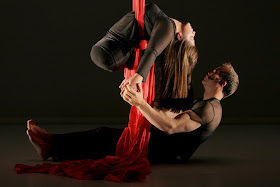
From the
Dance magazine review by Theodore Bale. In the picture, Jennifer Bricker and Nathan Crawford in the aerial overture to GIMP.
When six confident dancers (Christina Briggs, Lawrence Carter-Long, Jeffrey Freeze, Lezlie Frye, Catherine Long, and Heidi Latsky) walk slowly downstage in the opening scene of GIMP, each is looking directly, almost confrontationally, into the audience. Two of them have provocative slogans on their black T-shirts: “Keep staring, I might do a trick,” says one, and “Let’s get ready to stumble,” the other. The words reminded me that as a child, I was taught never to stare at disabled persons. I remained curious into adulthood, however, and the dancers in GIMP not only break this common taboo, they make the situation reciprocal: They stare back at you.
Subverting these well-established “polite” conventions of gaze is the starting point for this event, which skillfully blends political inquiry, psychology, and aesthetic explorations of form, structure, and dynamics. GIMP is without doubt a gleaming milestone in the progress of contemporary dance and theater, proving that the term “disabled dancer” is an oxymoron.
The performance began outdoors with a mesmerizing aerial overture and prologue to original live music by Stan Strickland and Randall Woolf. One definition of gimp is “a ribbon-like, braided fabric.” Jennifer Bricker (an accomplished aerialist and athlete without legs) and Nathan Crawford (a dancer with the Britney Spears “Circus” tour), used just that—a suspended stretch of long, crimson silk—for an intensely erotic duet. In a series of variations on spinning and clinging, each took turns manipulating the other within and around the fabric. In its abstract sense, it was a striking study in proportion and scale. When Crawford embraced Bricker, she became entirely concealed within his arms and torso. When she grounded one of his spinning episodes from far below, she appeared to be navigating a huge kite through a hurricane.
The stage portion of GIMP has an urban, night-club feel. Eva Mantell’s scrim projections of body parts, classic statuary, and animals, as well as Christopher Ash’s tense lighting design, provide a worthy landscape for a series of non-narrative duets and ensembles. Text is fragmentary. “Three cripples walk into a bar,” says Carter-Long at one moment, never finishing the joke. Certain episodes juxtapose the same movement or gesture by a dancer such as Latsky (with a traditional body) and a dancer whose arm finishes in a smooth point rather than a set of five splayed fingers, or another who has just one arm. The purpose here is not to assert any kind of qualitative hierarchy. Rather, the performers are like a thicket of trees subsisting on the same soil, light, and water, but each expressing its response to those elements with irrefutable distinction.
 From the Dance magazine review by Theodore Bale. In the picture, Jennifer Bricker and Nathan Crawford in the aerial overture to GIMP.
From the Dance magazine review by Theodore Bale. In the picture, Jennifer Bricker and Nathan Crawford in the aerial overture to GIMP.